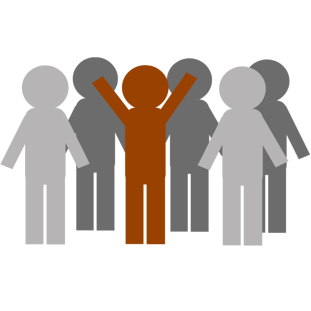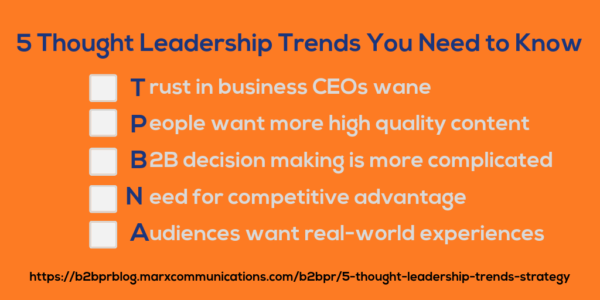— September 20, 2019

Thought leadership is a tested concept that works. But the tactics behind this strategy have changed. So what should you know about thought leadership as it is today? Let’s look at the top thought leadership trends that impact strategy and how you need to respond to these trends.
What You Need to Know About Thought Leadership Strategy
Before we get into what trends could affect your thought leadership strategy, let’s discuss the basics of thought leadership and why every brand should use it.
First, let’s consider what is thought leadership…
Thought leaders are looked up to in their business community because of their expertise and passion for what they do. They selflessly share useful content with their audience, which earns the trust of their audience.
Michael Brenner, a thought leader in his own right, puts it this way…
It’s not pedigree. It’s not where you went to school. Thought Leadership means you provide the best and deepest answers, to your customers’ biggest questions, in the formats your audience likes to consume.
As you can see from that explanation, a primary component of thought leadership is content. Content such as blog posts, ebooks, videos and infographics help thought leaders to connect with their audience and extend a helping hand.
Why should brands use thought leadership?
Thought leadership has proven its value time and time again. In one study from Grist 66% of senior level executives noted that they seek out thought leadership material that helps them to stay ahead of emerging trends and make better decisions.
Bottom line? Especially in the B2B industry, where purchase decisions are a complex process, thought leadership can help you to stand out. One study from Edelman and LinkedIn even showed that many executives awarded business to organizations based on their level of thought leadership — and such executives were willing to pay a premium price for that organization’s product or service.
But enough with the whats and whys. Let’s get into the trends that currently impact thought leadership, and what you need to do in response to the trends.
5 Thought Leadership Trends That You Need to Know
1. Trust in Business CEOs Wane
 Research shows that trust in businesses and business leaders are at an all-time low. For instance, only 37% of respondents in one study ranked CEOs as extremely or very credible, leaving 63% giving them a thumbs down.
Research shows that trust in businesses and business leaders are at an all-time low. For instance, only 37% of respondents in one study ranked CEOs as extremely or very credible, leaving 63% giving them a thumbs down.
It’s easy to understand how people must feel — with so many stories surfacing about how brands have cut corners. It’s no wonder that people look at business leaders with a skeptical eye.
Does this spell the end of thought leadership for business leaders? No. But it does provide a trajectory of what to do.
Knowing this, thought leaders need to work on earning the trust of their audience. That means communicating authentically with people and always supporting facts and figures with real data.
Behind this is the idea of being selfless. Doing things for the sake of your audience, not your brand. Providing helpful, actionable content. From such selflessness, trust will begin to grow.
2. People Want More High Quality Content
 Thought leadership content is crucial to your strategy. But trends show that not all content is created equal — and when content is not on par, thought leadership suffers.
Thought leadership content is crucial to your strategy. But trends show that not all content is created equal — and when content is not on par, thought leadership suffers.
Because of the quantity of content they consumer regularly, business decision makers are more discerning than ever in the content that they want. Thought leadership content has become so important in terms of purchase decisions that business leaders on average read around 3 pieces of content before they make a purchase decision.
Consider a study from Grist on The Value of B2B Thought Leadership, which surveyed over 200 senior level executives. When asked what turns them off about thought leadership, the top three reasons included that their content
- Was too generic (63%)
- Lacked original content or ideas (58%)
- Promoted the adviser rather than addressing my problems (53%)
How can you improve the quality of your thought leadership content? Focus on providing value to your audience with content that is genuinely helpful and answers their biggest questions. Take time to create original content that goes deeper and further than any other piece of content.
And, as we’ll get into more later, don’t promote your brand within your content. Your content should purely be for the advancement of your audience.
3. B2B Decision Making Is More Complicated

Many businesses have several individuals involved in purchase decisions. For example, let’s say your brand provides project management software geared toward large corporations. Before a brand buys your product, it might need the go-ahead of the CEO, CFO, COO, and perhaps others.
How can your strategy meet this challenge? As a thought leader, you need to be able to appeal to the concerns of each party involved in the purchase decision process. Create customer personas for each of these parties and prepare content that answers their key concerns.
Going back to our management software example, you might for instance address a company’s CFO with content about how management software helps a company’s bottom line.
4. Need for a Competitive Advantage

Every business needs a competitive advantage — something that sets it apart from other companies in its industry. This could be a key difference between your firm and a competitor, or simply something that your business offers that others don’t.
This has become even more necessary in recent years, with an influx of new companies to many industries.
As part of a well-rounded thought leadership strategy, you need to understand what makes your brand different. Become familiar with your competitive distinction. Understand what areas you excel in and take advantage of those.
As a thought leader, it’s important to carve out a specific area of expertise. More than that, select an area of expertise where a lot of experts don’t exist. If you notice a specific area of your industry lacks experts and content, that might be space for you to fill.
5. Audiences Want Real-World Experience
One study shows that senior business decision makers crave case studies that show a business in action. This is not merely customer testimonials; instead, it consists of in-depth studies that show the challenges that a business faced, and how your brand was able to help.
Companies want real-world, comprehensive examples of how organizations have solved industry problems, met challenges, and stayed on top of trends. Hone in on shining customer experiences that you can use as case studies. After a particular problem has been solved and a customer is happy with the work you’ve done, approach the customer about participating in a case study.
This approach will undoubtedly strengthen your reputation as a thought leader in your industry.
In review…

Thought leadership is a powerful tool for your brand. Thought leadership trends can empower your brand to overcome challenges and attain bonafide thought leadership status.
Business & Finance Articles on Business 2 Community
(75)









